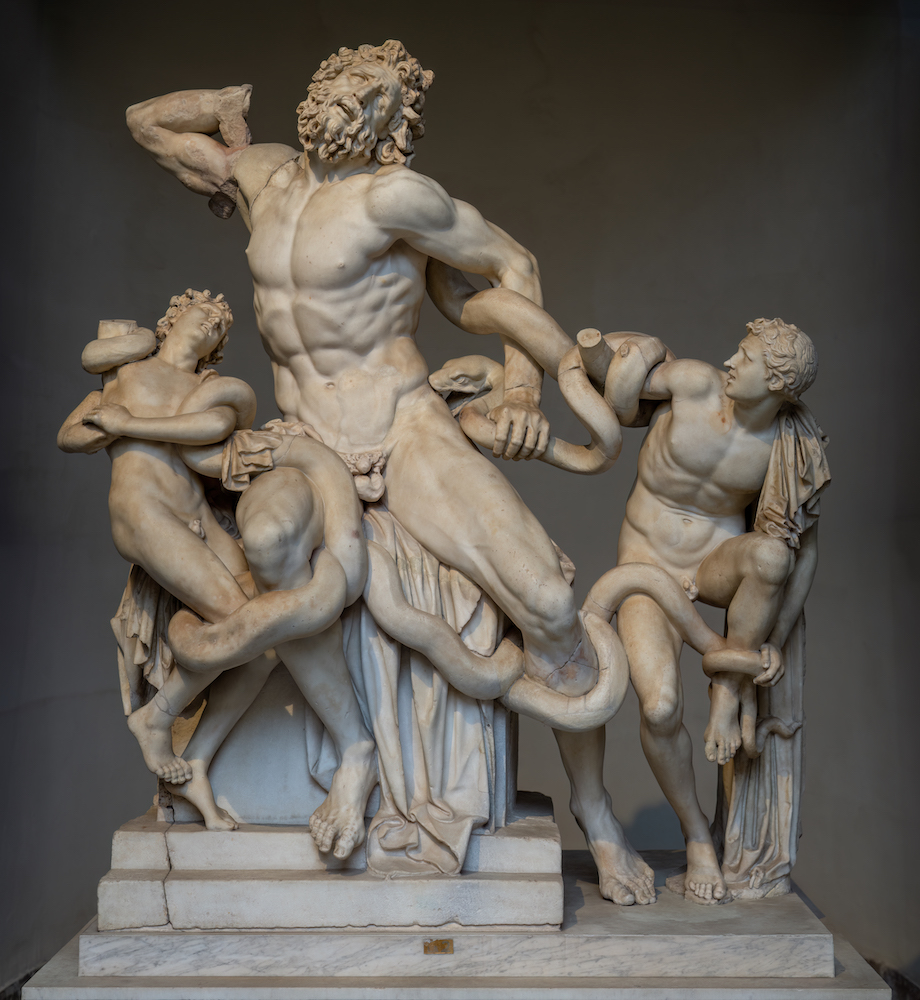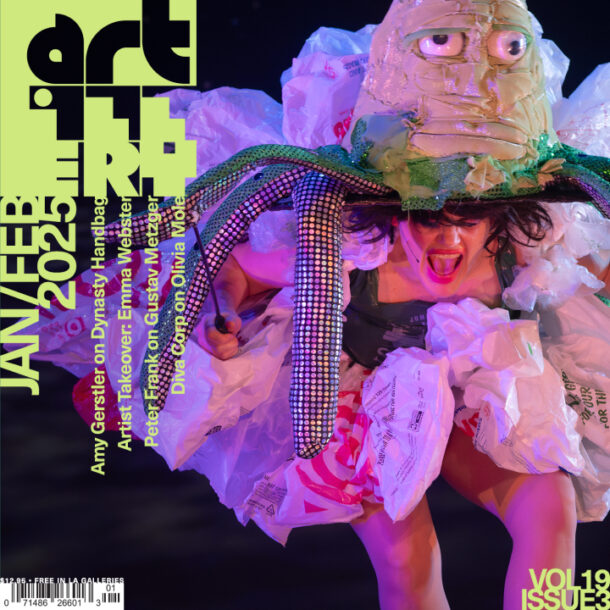The first draft of this article was entirely different. It was a polemic. A scorched-earth condemnation of art. Ten thousand words. The next wave in a storied line of seismic criticism. As such, I titled it Towards a Number Laocoön (“number” as in more numb, not integer), referencing the ancient Greek sculpture of the suffering priest (Laocoön) who tried to sound the alarm on the Trojan horse, and, more importantly, putting it in direct conversation with Laocoöns of critics past: Lessing’s Laocoön (1766), Babbitt’s The New Laokoon (1910),
Greenberg’s Towards a Newer Laocoön (1940), Lawson’s Toward AnotherLaocoön (1986), and Hainley’s Towards a Funner Laocoön (2000). Now more than ever, I was certain: we were at the precipice of something that had to do with a Laocoön.
The argument, to me, made sense: in Los Angeles, art is ignorant of the present.
I called for more work that contends with our reality—whether materially, thematically, affectively, or otherwise—especially because art, malleable and oft-formless that it can be, is naturally amenable to it. It’s kind of the point of the whole thing—destabilizing the standard, expanding the possible—and would be a welcome reprieve from the somewhat stilted and outworn approaches of the day.
What a public service this essay would be, I imagined, and what a revelation. I dreamt of going to Taix on the night of the article’s release. I’d sit there—ignored by the waitress, as always—and eavesdrop on a nearby table as they discussed it.
“… Finally! Someone said it!”
“Right? We were all thinking it, just no one wanted to confront it—”
“Yeah… for a second there it felt like we believed in ‘the end of art,’ or something…”
“But now—”
And before I could hear what exactly they thought about now, the waitress would come, and I’d be pulled in the direction of a martini.
This was pure fantasy, of course. Taix waitresses never come at inopportune moments, because they never come at all. That, and the feedback from my editor was basically, “Well, yeah, duh. But so what?” and an order to rewrite. In a panic, I checked with some friends, floated my thesis to strangers at openings, and even ordered ChatGPT to give it a read. Responses were, again, less than encouraging.
I mean, okay, but we’re not in art school anymore… // Art shouldn’t be, like, an ever-expanding amoeba. After a while, it just is what it is… // Oh come on, it’s art. It’ll never be relevant again…
You get the gist. Someone even called my ideas “Mickey Mouse,” and suggested I “wake up and smell the coffee,” to which I pointed out that my insurance covered none of this, that I was paying her, and that I could leave at any time, to which she said, “Fine. I’ve got a full waitlist, don’t let the door hit you on the way out,” and now I have forty-five minutes to fill every Friday for the foreseeable future. (If anyone has a good psych, DM me.)
It was devastating. Why didn’t everyone believe in art the way I did? Why was everyone so content to examine the present with the tools of the past? And if it was all so obvious, why didn’t anyone do anything about it?
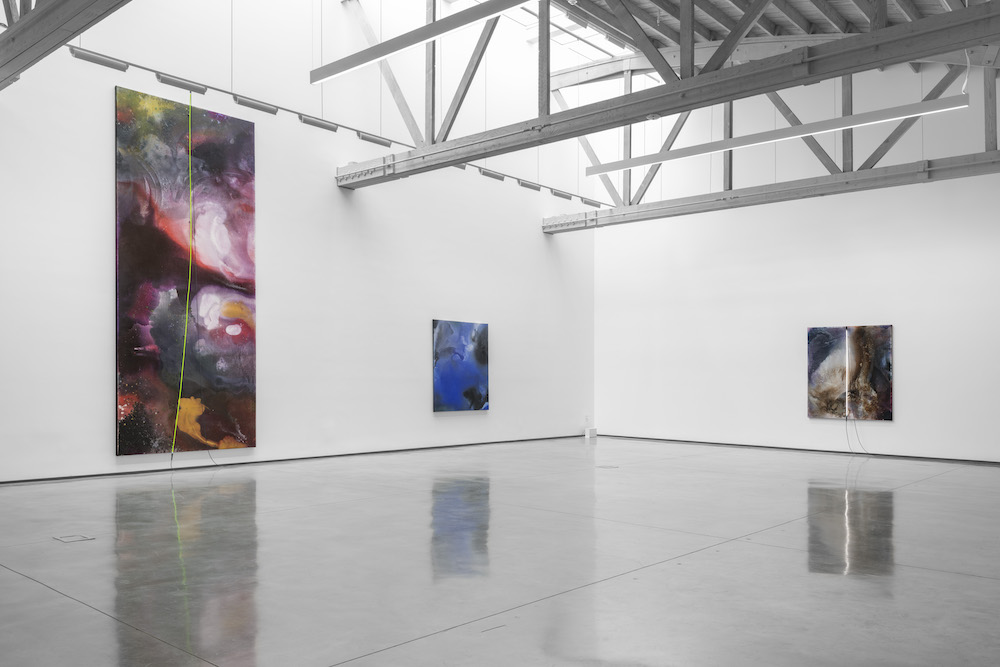
Mary Weatherford, “The Surrealist,” 2025 exhibition view. Courtesy of David Kordansky Gallery.
My point was a local one, though maybe it’s a universal truth, too. Who knows? I don’t live in the universe; I live in LA. Very few shows here reflect the reality in which we live. A reality that’s neither entirely offline nor entirely on, that constantly toggles between virtual and physical realms that are rarely in sync. One where we style ourselves as main characters, optimizing and refining our image for the algorithm, but where we’re also somewhat pathetic bit players, too, driving to 7-Eleven for dinner with our fender duct-taped to the trunk.
Basically, in spite of all the post-internet art (the cybernetic nightmare kitsch, the technoromance that aspires to meld mind with machine), and all the classical “updates” (quotidian moments in the style of Bonnard, oil paintings of memes, ceramics shaped like Zelda characters), and all the conceptual work that tackles our current crises (geopolitical, racial, environmental, and the like), I don’t really get the sense that form and content are comingling in a way that speaks to the present moment.
Not that all art has to, but where’s the work that takes as its starting point our virtual/physical split? That uses tech, but isn’t about tech? That speaks with the same pace and texture that we do, and strikes us, effectively, in so doing?
For me, these questions were almost too obvious, especially since no one was asking them. They became doubly glaring after the LA premieres of two independent films in May—Eugene Kotlyarenko’s The Code (2024) and Peter Vack’s www.RachelOrmont.com—films that, while vastly different and imperfect in their own ways, both make explicit attempts to capture the speed, aesthetics, and contradictions of our lives. Kotlyarenko’s film embraces the panopticon, using footage from just about every camera available—Ring cams, drones, TikTok feeds, iPhones, GoPros, Teslas, and more—and splices it all together at a brainrot fever pitch to tell a modern love story. Vack’s film, though not as formally experimental as it seems to think it is, successfully locates our techno-surreality by distilling scenes into memeable components on a soundstage, before opening up to the shock of the “real world.” Each film also casts internet personalities (however niche) in various roles; most notably, Dasha Nekrasova of Red Scare stars in both.
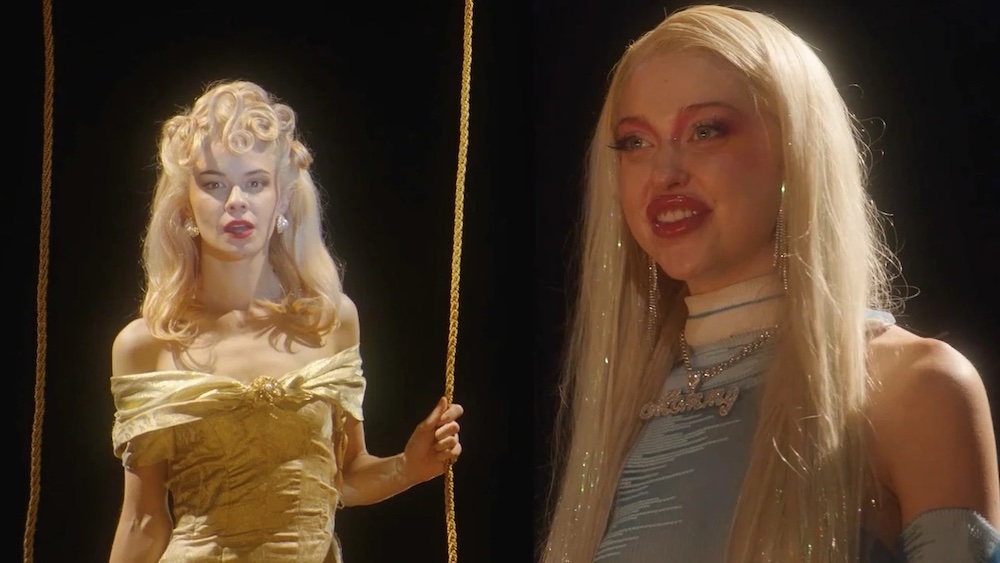
Still from www.RachelOrmont.com (2024), Dir. Peter Vack. Credit: Peter Vack.
Now, this doesn’t mean these films are entirely successful in capturing the tides of the present, just that their intent to chase those tones, and to address them boldly, is a welcome development in a creative landscape that shies away from doing so at every turn. In fact, so-called luminaries often unintentionally (yet quite proudly) advocate in favor of ignorance and formal stagnation. After all, it was Martin Scorsese who, only a few years ago, couldn’t see beyond his own nose as he praised the 1960s avant-garde filmmakers for challenging the medium of film, while in the same breath qualifying new technologies and viewing habits as a threat to the enterprise, rather than, you know, as devices through which to (re)challenge it.
Reeling from it all, I went to my happy place—Taix, of course—and after a fistful of martinis, an old woman sat down beside me. She told me she knew what my problem was and how to solve it. She handed me a pair of sunglasses. “Wear these to the galleries,” she said. I looked at them. Inscribed on the inside arm were the words: For my jaded angels. I told her I’d have to think about it. She snatched the glasses back. “Follow me,” she said.
We went to Mary Weatherford’s show at Kordansky; large-scale abstraction, a retread of her own retread. “What do you think?” the old woman asked me. I told her I felt very little, that this art didn’t make sense in 2025. Her eyes widened, and she offered me the sunglasses again. “Here. Now try.” I put them on. All of a sudden: Welcome to the post-war era. Everyone in the gallery was styled in long skirts, rounded shoulders, double-breasted suits, and wide ties. People drank sidecars instead of Modelos. Outside, a Chevy Bel Air rumbled off into the night, allegedly heading to the afters at Rita Hayworth’s house.
With the glasses on, the art sort of made sense. At the very least, it matched the spirit of its time: Formally constrained and traditional, curious for more. How exhilarating, I thought, to experience history as if it hadn’t yet happened.
And so we went to galleries all night. At Ochi’s Paige Turner-Uribe show—which was full of paintings that merged Mary Cassatt with a Post-Impressionist Nabis sensibility—everyone arrived on bicycles and wore bell-shaped skirts, frock coats, and fancy hats with flowers. The crowd at Drake Carr’s show at Megan Mulrooney—portraits reminiscent of Antonio Lopez’s fashion illustrations—looked like the line to get into Paris’ Club Sept in the early 70s, with feathered boas, platforms, satin, and glitter galore. During the opening of Morán Morán’s “PLAY” group show, I even caught a glimpse of Jackson Pollock smoking, studying the surface of Lauren Quin’s painting, forgiving himself of his trademark scowl in favor of something a bit lighter.
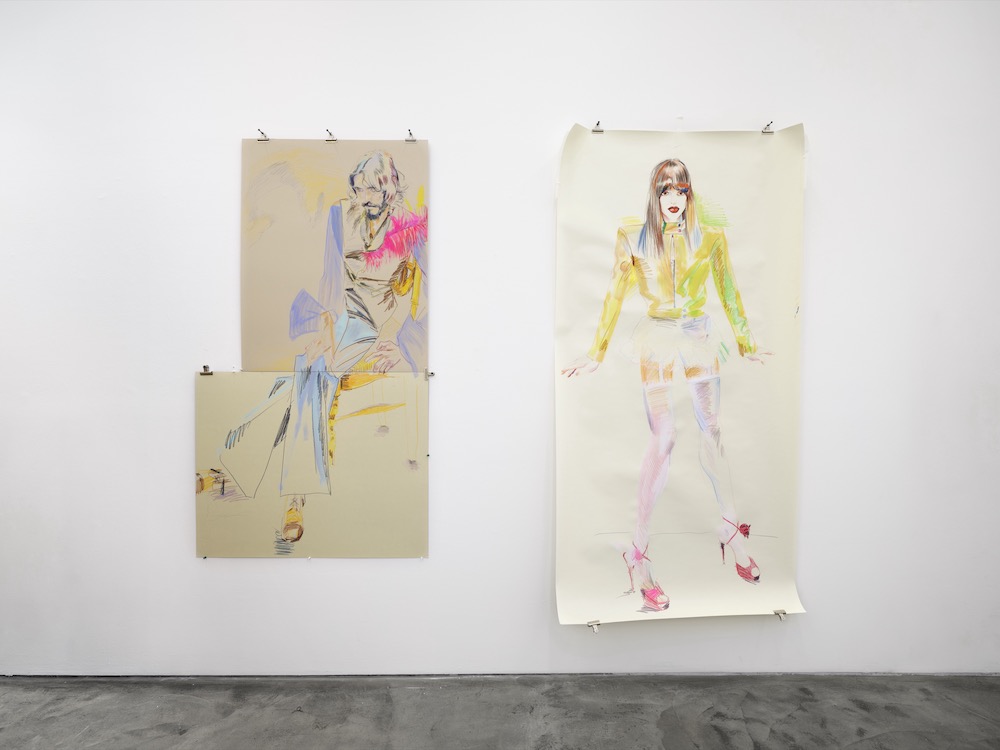
© Drake Carr; Photo by Paul Salveson; Courtesy of the artist and Megan Mulrooney Gallery
And then, just as I was beginning to settle into my ancient surrounds at Karin Gulbran’s ceramics show at Parker Gallery, someone grabbed my shoulder and shook me from behind. “Hey… Hey! You gotta go,” they said. I tried to ignore them, but they kept shaking me, so finally I whipped my head around and…
I was back at Taix. The old woman, the glasses…nowhere to be found.
“No sleeping in here,” my waitress said. She handed me the bill.
On my way home, I stopped by Erin Calla Watson’s show at Ehrlich Steinberg. Here were half a dozen works on mirrored glass, prints of digitally rendered spaces that emphasized doubling silhouettes, that peeled back the veneer of reality. They were formal and fit for the gallery, sure, but they also toyed with the vernaculars of the present, implicating the viewer as a physical agent—or at least the reflection of one—amidst the work’s eerie virtuality.
I wondered what I’d see if I were wearing the glasses, the jaded angels, in here. I thought long and hard.
They probably wouldn’t change a thing, I figured.
Maybe this was it. Maybe that meant there was hope. Maybe we didn’t need to think about another Laocoön, after all.

